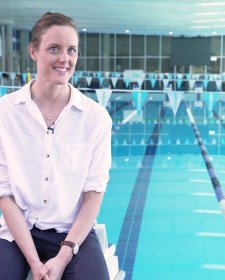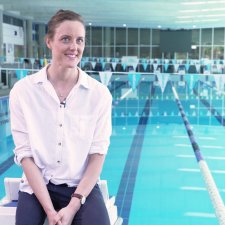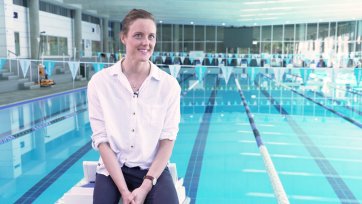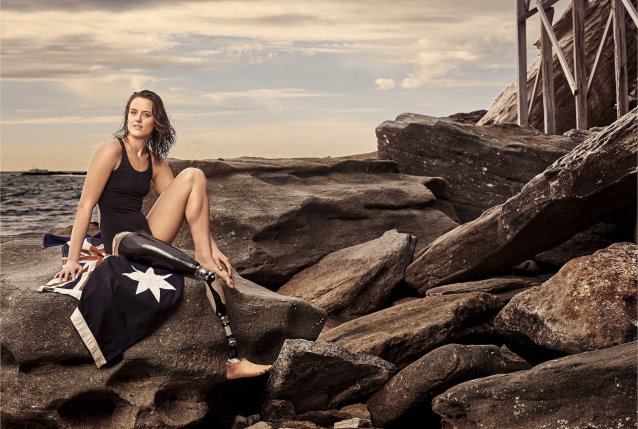Wylie’s Baths in Coogee, NSW is the dramatic backdrop for Peter Brew-Bevan’s portrait of Australia’s most decorated female Paralympian Ellie Cole OAM (b. 1991). After being diagnosed with a rare form of cancer in her right leg, Cole underwent surgery to amputate the limb above the knee at age three. Her parents enrolled her in swimming lessons to help with her rehabilitation. Fifteen when she competed in the World Championships for the first time, she has since amassed three world titles, four Commonwealth medals, nine Pan Pacific gold medals and seventeen Paralympic medals, including silver and bronze medals at her fourth and final Paralympics in Tokyo in 2021.
Portrait Story
by Ellie Cole AM, 19 January 2022
For me, swimming was particularly special because it was the only sport that I could participate in as a kid where I could take my prosthetic leg off, jump in the water, and I could be the same as all the other kids. And then I found after a while that I could actually be better than most of my friends at that sport. It gave me a really great platform to show all of my friends at school that I could still achieve things in a physical sense, because I definitely wasn’t running up and down beside them in the playground, but get me into a pool, and I’ll beat you.
The pool was definitely a great place of freedom, but it was where I learned how to back myself, how to be resilient, how to show the world what I could do. And then I found my way onto the Paralympic team with that exact same attitude and have since seen how the Paralympics can show the world what their athletes can do.
Being a Paralympian is the best job in the world. The most proud that I’ve ever been is when I won my gold medal in the 100-metre backstroke at Rio, because I had been racing for nine days, and I’d been chasing gold medals, but I’d always be getting touched out and getting silver, which is still great. But I got to day nine, and I had one last chance to win a gold medal. And I was so stressed out before the event that I locked myself in a toilet cubicle and had a mild panic attack and didn’t think that I could go out there and race. And I got myself out of the toilet cubicle, and I walked onto the pool deck. And I jumped in, and I won the race. It was the greatest moment ever.
I did that photo shoot with Peter right before the Rio Paralympic Games. And it was a moment where we really wanted to showcase the athletes of Australia that were going to the Olympics and the Paralympics. I always dreamed of being a mermaid when I was younger. So to be able to capture that in a portrait, as well as the strength and showcasing my disability as well and combining that into my childhood dream, with the inclusion of being strong and powerful, was a really great photo for me. I always look at it and think, “That’s not me”. But it is. It’s just beautiful. To be able to just showcase my disability is something that I can’t really put into words.
When I was younger, I never saw people or role models that had a disability. It’s really a dream come true, just to be able to show the world that you can still be a mermaid. You can still have a disability. You can still be a Paralympian. You can do whatever you like.
Related information




Ellie Cole
'I always dreamed of being a mermaid'
Portrait storyEllie Cole on the freedom of the pool and being photographed by Peter Brew-Bevan.



Portrait 66, Summer 2021/22
Magazine
The Huxleys, National Portrait Gallery London’s masterpieces, Jennifer Higgie on portraits of women by women, Tamara Dean, Bangarra, Glynis Jones on fashion photographers, and NPG/NGV collaboration.



Take thy face hence
Magazine article by Joanna Gilmour
Joanna Gilmour travels through time to explore the National Portrait Gallery London’s masterpieces in Shakespeare to Winehouse.





